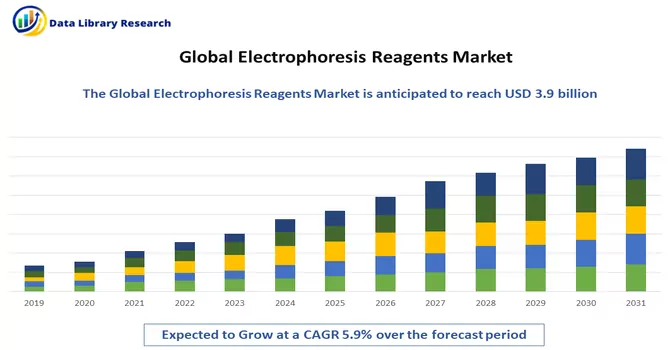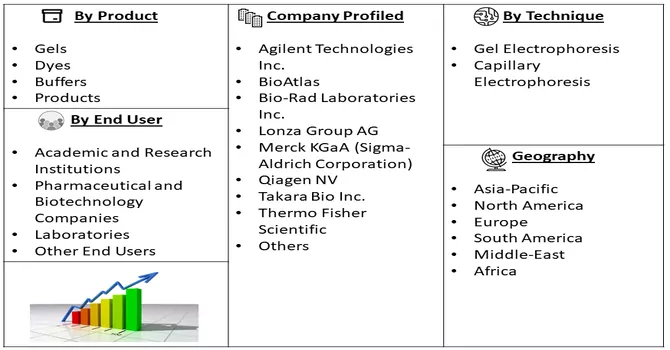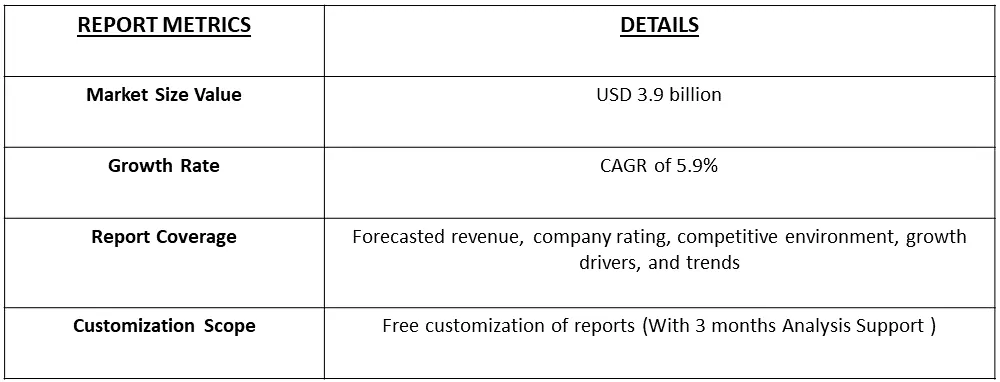The Electrophoresis Reagents Market size is forecast to reach USD 3.9 billion by 2023, growing at a CAGR of 5.9% during the forecast period 2024-2031.

Get Complete Analysis Of The Report - Download Free Sample PDF
Electrophoresis reagents encompass a range of substances essential for the laboratory technique of electrophoresis, enabling the separation and analysis of macromolecules like DNA, RNA, and proteins based on size and charge. Key components include electrophoresis buffers (e.g., TAE or TBE), gel matrices (agarose for nucleic acids, polyacrylamide for proteins), stains and dyes (ethidium bromide for DNA, Coomassie Blue for proteins), loading buffers, running buffers, and molecular weight markers. These reagents collectively facilitate the visualization and estimation of molecular sizes during electrophoretic processes, contributing to various applications in molecular biology and biochemistry, such as DNA profiling, RNA analysis, and protein characterization.
The Electrophoresis Reagents market is driven by several growth factors contributing to its expansion. Firstly, the increasing prevalence of genetic disorders and rising demand for molecular diagnostics propel the need for DNA and RNA analysis, fostering the adoption of electrophoresis techniques. Additionally, advancements in proteomics research and drug discovery drive the demand for protein separation and analysis, further boosting the market. Technological innovations in electrophoresis reagents, such as the development of novel staining agents and precast gels, enhance efficiency and convenience, attracting researchers and laboratories. Moreover, the expanding applications of electrophoresis in fields like forensics, biotechnology, and pharmaceuticals contribute to market growth. The growing awareness of personalized medicine and the continuous evolution of genomics and proteomics research also stimulate the demand for electrophoresis reagents, creating a favourable landscape for market expansion.
Several market trends are shaping the Electrophoresis Reagents market. Firstly, there is a notable shift towards automated and high-throughput electrophoresis systems, driven by the need for increased efficiency and reduced hands-on time in laboratories. Additionally, the adoption of capillary electrophoresis is gaining momentum, offering higher resolution and faster analysis, particularly in DNA sequencing applications. Another trend involves the increasing demand for eco-friendly and safer alternatives to traditional staining agents, with a focus on developing reagents that minimize environmental impact and improve user safety. Furthermore, the market is witnessing a surge in the use of precast gels and ready-to-use reagent kits, simplifying experimental procedures and catering to the demand for user-friendly solutions. The integration of electrophoresis techniques with advanced technologies such as artificial intelligence and machine learning is also emerging as a trend. This integration enhances data analysis, interpretation, and automation, contributing to more accurate and reproducible results. Moreover, there is a growing emphasis on the development of multiplexing techniques, enabling simultaneous analysis of multiple samples and targets, thus saving time and resources. As the demand for personalized medicine and companion diagnostics rises, the Electrophoresis Reagents market is experiencing an increased focus on specialized reagents catering to specific research needs. Lastly, collaborations and partnerships between key market players and research institutions are becoming common, fostering innovation and the development of customized electrophoresis reagents tailored to diverse applications in genomics, proteomics, and clinical diagnostics.
Market Segmentation: The Electrophoresis Reagents Market is Segmented by Product (Gels, Dyes, Buffers, and Other Products), Technique (Gel Electrophoresis and Capillary Electrophoresis), End User (Academic and Research Institutions, Pharmaceutical and Biotechnology Companies, Laboratories, and Other End Users), and Geography (North America, Europe, Asia-Pacific, Middle-East and Africa, and South America). The report offers the value (in USD million) for the above segments.

For Detailed Market Segmentation - Download Free Sample PDF
Market Drivers:
Increasing Funding for Genomic and Proteomic Research
The Electrophoresis Reagents market is experiencing a significant boost due to the increasing funding dedicated to genomic and proteomic research. The surge in financial support from government institutions, private organizations, and research grants is driving advancements in genomics and proteomics, subsequently fueling the demand for electrophoresis reagents. Genomic and proteomic research plays a crucial role in understanding the genetic basis of diseases, identifying biomarkers, and developing targeted therapies. As funding continues to flow into these areas, researchers have access to more resources, enabling them to conduct in-depth studies that often involve the use of electrophoresis techniques for DNA, RNA, and protein analysis. Governments and non-profit organizations worldwide recognize the potential of genomics and proteomics in advancing medical science, and as a result, they allocate substantial funds to support research initiatives. This financial backing not only facilitates basic research but also accelerates translational and clinical studies, where electrophoresis reagents are integral for molecular analysis. Private investment in biotechnology and pharmaceutical companies focused on genomics and proteomics further contributes to the growth of the Electrophoresis Reagents market. These companies heavily rely on electrophoresis techniques for their research and development activities, driving the demand for high-quality reagents. The availability of funding also encourages innovation in electrophoresis reagents, leading to the development of more advanced and specialized products. This, in turn, enhances the overall capabilities of electrophoresis methods, making them even more valuable in various applications within the genomics and proteomics domains. Thus, the increasing funding for genomic and proteomic research serves as a catalyst for the Electrophoresis Reagents market, fostering advancements in molecular analysis and contributing to the overall progress in understanding the intricacies of genetic and protein-related phenomena.
Rising Prevalence of Chronic Diseases
The rising prevalence of chronic diseases globally has become a driving force behind the growth of the Electrophoresis Reagents market. Chronic conditions such as cancer, cardiovascular diseases, and neurological disorders often necessitate detailed molecular analysis for accurate diagnosis, prognosis, and treatment decisions. Electrophoresis techniques, supported by specialized reagents, play a crucial role in this analytical process. The need for understanding the genetic and proteomic aspects of chronic diseases is pushing the demand for electrophoresis reagents. Researchers and clinicians utilize these reagents to separate and analyze nucleic acids and proteins, allowing them to identify specific markers, mutations, or aberrant protein expressions associated with various chronic conditions. In cancer research, for instance, electrophoresis reagents are instrumental in profiling DNA mutations or analyzing RNA expression patterns, aiding in the identification of potential biomarkers and therapeutic targets. The versatility of electrophoresis makes it applicable to a wide range of chronic diseases, providing valuable insights into the molecular mechanisms underlying these conditions. As the prevalence of chronic diseases continues to rise globally, governments, healthcare institutions, and research organizations are investing significantly in diagnostic and therapeutic research. This increased focus on precision medicine and personalized treatment strategies further propels the use of electrophoresis reagents. Moreover, the expanding biopharmaceutical industry, driven by the need for targeted therapies and precision medicine, relies heavily on electrophoresis techniques for protein characterization and analysis. The development of new drugs and therapies often involves studying the behavior of specific proteins associated with chronic diseases, creating a sustained demand for high-quality electrophoresis reagents. Thus, the rising prevalence of chronic diseases has become a major catalyst for the growth of the Electrophoresis Reagents market. The ability of electrophoresis techniques to provide detailed molecular information aligns with the growing emphasis on personalized medicine and targeted interventions, making these reagents indispensable in the quest to better understand, diagnose, and treat chronic health conditions.
Market Restraints:
Presence of Other Alternatives
The Electrophoresis Reagents market faces challenges from alternative technologies, notably Next-Generation Sequencing (NGS) in genomics and mass spectrometry in proteomics, as well as emerging microfluidics-based platforms and gel-free separation methods. NGS's high-throughput capabilities and comprehensive genomic data, coupled with the efficiency of mass spectrometry and other innovative techniques, present alternatives that compete with traditional electrophoresis methods. As these technologies advance, offering higher throughput and efficiency, the electrophoresis reagents market must adapt through continued innovation to maintain its relevance, focusing on enhancing efficiency, sensitivity, and application-specific advantages.
The COVID-19 pandemic initially posed challenges for the Electrophoresis Reagents market, causing disruptions in research activities and supply chains. However, as the focus shifted towards genomic and proteomic research related to the virus and the development of COVID-19 vaccines, there was a resurgence in demand for electrophoresis reagents, particularly for RNA analysis and protein characterization. The pandemic underscored the critical role of molecular biology in public health, potentially influencing the long-term trajectory of the market as research activities continue to evolve in response to emerging health challenges.
Segmental Analysis:
Ethidium Bromide (ETBR) Dyes Segment is Expected to Witness Significant Growth Over the Forecast Period
The Ethidium Bromide (ETBR) Dyes and Electrophoresis Reagents Market is characterized by a dynamic landscape driven by the widespread use of ETBR as a DNA stain in electrophoresis applications. ETBR dyes are extensively employed for visualizing and analyzing nucleic acids due to their fluorescent properties. The market exhibits ongoing competition and moderate fragmentation among key players, with strategic initiatives such as new product developments, collaborations, and mergers and acquisitions playing a pivotal role in shaping the industry landscape. The increasing demand for efficient and safer alternatives to ETBR, along with advancements in electrophoresis technologies, contributes to the market's evolution, emphasizing the need for continuous innovation in reagent formulations and diagnostic tools.
Gel Electrophoresis Segment is Expected to Witness Significant Growth Over the Forecast Period
The Gel Electrophoresis and Electrophoresis Reagents Market is witnessing significant growth driven by the expanding applications of gel electrophoresis in molecular biology and the life sciences. Gel electrophoresis, a widely used technique for separating and analyzing nucleic acids and proteins based on their size and charge, serves as a fundamental tool in various research domains, including genomics, proteomics, and forensic science. The market is characterized by a diverse range of electrophoresis reagents such as buffers, stains, gels, and molecular weight markers that are crucial for achieving accurate and reproducible results. Factors such as the rising prevalence of genetic disorders, advancements in personalized medicine, and increased funding for genomic and proteomic research contribute to the market's expansion. Additionally, the introduction of innovative reagents and gel formulations, coupled with a growing focus on environmentally friendly and user-safe options, shapes the competitive landscape. As the demand for precise molecular analysis continues to grow, the Gel Electrophoresis and Electrophoresis Reagents Market are poised for further advancements and adoption in research, diagnostics, and pharmaceutical applications.
Academic and Research Institutions Segment is Expected to Witness Significant Growth Over the Forecast Period
Academic and research institutions play a pivotal role in driving the Gel Electrophoresis Reagents market, serving as key end-users and contributors to advancements in molecular biology and related fields. Gel electrophoresis, a fundamental technique in these institutions, is extensively employed for nucleic acid and protein separation, contributing to various scientific studies and discoveries. The demand for gel electrophoresis reagents in academic settings is fueled by research initiatives spanning genomics, proteomics, microbiology, and biochemistry. These institutions continually explore novel applications of gel electrophoresis in diverse research projects, including genetic studies, biomarker identification, and drug development. Gel electrophoresis reagents, such as specialized stains, buffers, and gels, are indispensable tools in these endeavors, facilitating the accurate visualization and analysis of biomolecules. Moreover, the need for reproducibility and reliability in research outcomes reinforces the importance of high-quality electrophoresis reagents in academic laboratories. The academic sector's influence on the Gel Electrophoresis Reagents market is further amplified by collaborations and partnerships between reagent manufacturers and research institutions. Such alliances foster the development of tailored reagents to meet specific academic research needs, leading to continuous innovation and product enhancements. As academic institutions continue to be at the forefront of scientific exploration, the Gel Electrophoresis Reagents market benefits from a consistent demand for cutting-edge technologies and reagents. The symbiotic relationship between academic research and the market underscores the significance of gel electrophoresis in advancing our understanding of molecular biology and underscores the critical role of high-quality reagents in these scientific endeavours.
North America Region is Expected to Witness Significant Growth Over the Forecast Period
North America plays a significant role in shaping the Electrophoresis Reagents market, with the region experiencing robust growth driven by advancements in molecular biology, genetic research, and proteomics. The presence of a well-established biotechnology and pharmaceutical industry, along with a high concentration of academic and research institutions, contributes to the extensive utilization of electrophoresis techniques and reagents. The increasing prevalence of chronic diseases, coupled with a growing emphasis on personalized medicine, fuels the demand for molecular analysis tools, thereby driving the adoption of electrophoresis reagents. Government initiatives, research funding, and collaborations between industry players and research institutions further stimulate market growth in North America. The United States, in particular, stands out as a major contributor to the Electrophoresis Reagents market, with a strong focus on research and development activities. The region is characterized by a competitive landscape where key market players strategically engage in mergers, acquisitions, and partnerships to enhance their product portfolios and maintain a competitive edge. North America's inclination toward advanced healthcare technologies and its commitment to cutting-edge research initiatives position the Electrophoresis Reagents market for continual expansion. The region's demand for high-quality reagents is underscored by the need for precision medicine, diagnostics, and the development of therapeutic interventions, further solidifying North America's role as a pivotal market force in the Electrophoresis Reagents industry.

Get Complete Analysis Of The Report - Download Free Sample PDF
The market for Electrophoresis Reagents displays a moderate level of fragmentation and competitiveness. Key industry players are observed employing diverse strategies to fortify their market positions, including entering into agreements, expanding their operations, forming contracts, establishing partnerships, introducing new reagents, engaging in joint ventures, and pursuing mergers and acquisitions. These strategic maneuvers underscore the dynamic nature of the market, with companies actively seeking opportunities to enhance their product portfolios, expand their market presence, and foster innovation through collaborative initiatives. The competitive landscape reflects a continual effort among major players to stay at the forefront of the Electrophoresis Reagents Market through strategic and multifaceted business approaches. Some of the market players working in this market segment are:
Recent Development:
1) In August 2022, Amerigo Scientific, a dedicated distributor serving the biomedical and life science communities, unveiled its latest product, the CALX8 Reagent, catering to the needs of life science laboratory scientists. This reagent finds extensive applications in various molecular biology research processes, including cell lysis, protein purification, electrophoresis, and immunoassays. The introduction of CALX8 underscores Amerigo Scientific's commitment to providing innovative solutions for molecular research applications.
2) In June 2022, Advanced Electrophoresis Solutions Ltd. successfully secured pre-Series A investment from GCI Capital based in Toronto and Celtic House Asia Partners. The investment injection was strategically obtained to support the expansion of the electrophoresis product pipeline and other company initiatives. This financial backing reflects the confidence of investors in Advanced Electrophoresis Solutions Ltd.'s potential for growth and innovation within the electrophoresis market, highlighting the company's efforts to enhance its product offerings and meet evolving research needs.
Q1. What was the Electrophoresis Reagents Market size in 2023?
As per Data Library Research the Electrophoresis Reagents Market size is forecast to reach USD 3.9 billion by 2023.
Q2. At what CAGR is the Electrophoresis Reagents market projected to grow within the forecast period?
Electrophoresis Reagents market is growing at a CAGR of 5.9% during the forecast period.
Q3. What are the factors driving the Electrophoresis Reagents market?
Key factors that are driving the growth include the Increasing Funding for Genomic and Proteomic Research and Rising Prevalence of Chronic Diseases.
Q4. Which region has the largest share of the Electrophoresis Reagents market? What are the largest region's market size and growth rate?
North America has the largest share of the market . For detailed insights on the largest region's market size and growth rate request a sample here
Data Library Research are conducted by industry experts who offer insight on industry structure, market segmentations technology assessment and competitive landscape (CL), and penetration, as well as on emerging trends. Their analysis is based on primary interviews (~ 80%) and secondary research (~ 20%) as well as years of professional expertise in their respective industries. Adding to this, by analysing historical trends and current market positions, our analysts predict where the market will be headed for the next five years. Furthermore, the varying trends of segment & categories geographically presented are also studied and the estimated based on the primary & secondary research.
In this particular report from the supply side Data Library Research has conducted primary surveys (interviews) with the key level executives (VP, CEO’s, Marketing Director, Business Development Manager and SOFT) of the companies that active & prominent as well as the midsized organization
FIGURE 1: DLR RESEARH PROCESS

Extensive primary research was conducted to gain a deeper insight of the market and industry performance. The analysis is based on both primary and secondary research as well as years of professional expertise in the respective industries.
In addition to analysing current and historical trends, our analysts predict where the market is headed over the next five years.
It varies by segment for these categories geographically presented in the list of market tables. Speaking about this particular report we have conducted primary surveys (interviews) with the key level executives (VP, CEO’s, Marketing Director, Business Development Manager and many more) of the major players active in the market.
Secondary ResearchSecondary research was mainly used to collect and identify information useful for the extensive, technical, market-oriented, and Friend’s study of the Global Extra Neutral Alcohol. It was also used to obtain key information about major players, market classification and segmentation according to the industry trends, geographical markets, and developments related to the market and technology perspectives. For this study, analysts have gathered information from various credible sources, such as annual reports, sec filings, journals, white papers, SOFT presentations, and company web sites.
Market Size EstimationBoth, top-down and bottom-up approaches were used to estimate and validate the size of the Global market and to estimate the size of various other dependent submarkets in the overall Extra Neutral Alcohol. The key players in the market were identified through secondary research and their market contributions in the respective geographies were determined through primary and secondary research.
Forecast Model
